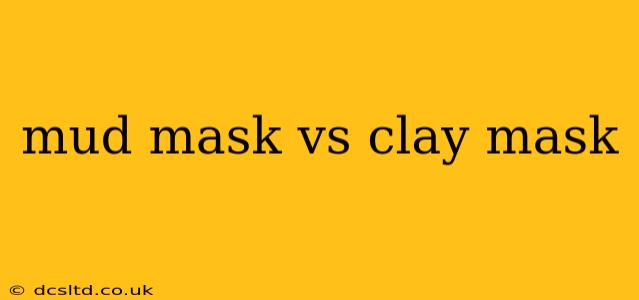Choosing between a mud mask and a clay mask can feel overwhelming. Both promise skin rejuvenation, but understanding their subtle yet significant differences is key to selecting the right one for your skin type and concerns. This comprehensive guide will explore the nuances of each, helping you make an informed decision for a healthier, more radiant complexion.
What is a Mud Mask?
Mud masks, often sourced from mineral-rich volcanic muds, are known for their deep cleansing and detoxifying properties. These masks typically contain a blend of minerals like sulfur, zinc, and magnesium, alongside other beneficial ingredients. The unique texture and composition of mud masks contribute to their ability to draw out impurities and excess oil from the pores.
What are the benefits of a mud mask?
- Deep Cleansing: Mud masks excel at drawing out dirt, oil, and impurities trapped within the pores, leaving skin feeling incredibly clean.
- Detoxification: The mineral-rich composition helps to detoxify the skin, removing environmental pollutants and other harmful substances.
- Improved Skin Texture: Regular use can improve skin texture, leaving it smoother and more refined.
- Reduced Breakouts: By unclogging pores, mud masks can help prevent and reduce the occurrence of breakouts.
What is a Clay Mask?
Clay masks, primarily composed of various types of clay (e.g., kaolin, bentonite, rhassoul), also offer deep cleansing benefits. However, different clays possess unique properties, leading to variations in their effects on the skin. For instance, bentonite clay is known for its oil-absorbing capabilities, while kaolin clay is gentler and suitable for sensitive skin.
What are the benefits of a clay mask?
- Oil Absorption: Certain clay masks, like those containing bentonite, are exceptionally effective at absorbing excess oil, making them ideal for oily and acne-prone skin.
- Exfoliation: Some clay masks offer mild exfoliating properties, helping to remove dead skin cells and promote cell turnover.
- Minimized Pores: The tightening effect of some clay masks can temporarily minimize the appearance of pores.
- Improved Skin Tone: Regular use can contribute to a more even and radiant skin tone.
Mud Mask vs. Clay Mask: Key Differences
While both mud and clay masks offer cleansing benefits, their composition and effects differ slightly:
| Feature | Mud Mask | Clay Mask |
|---|---|---|
| Primary Ingredient | Volcanic mud and minerals | Various types of clay (e.g., kaolin, bentonite) |
| Texture | Typically thicker, richer texture | Can vary depending on the type of clay used |
| Oil Absorption | Moderate to high | High (especially bentonite clay) |
| Suitable Skin Types | Normal, oily, combination | Oily, combination, acne-prone (depending on clay type) |
| Gentle Exfoliation | Usually less exfoliating than clay masks | Some clay masks offer gentle exfoliation |
What type of clay mask is best for sensitive skin?
Kaolin clay is generally considered the gentlest type of clay for sensitive skin. Its mild nature makes it less likely to cause irritation or dryness. Always perform a patch test before applying any new mask to your entire face.
Which mask is best for oily skin?
For oily skin, a bentonite clay mask is often the most effective due to its superior oil-absorbing properties. It can help control sebum production and leave the skin feeling less greasy.
Can I use a mud or clay mask every day?
No, it's generally not recommended to use a mud or clay mask every day. Overuse can lead to dryness, irritation, and even damage to the skin's protective barrier. Aim for 1-2 times a week, depending on your skin type and the specific mask's instructions.
How often should I use a mud mask or clay mask?
The frequency of use depends on your skin type and the product's instructions. For most, 1-2 times per week is ideal. Overuse can lead to dryness and irritation.
Conclusion
Both mud and clay masks offer valuable benefits for skin health. The best choice depends on your specific skin type and concerns. By understanding the nuances of each, you can select the mask that best addresses your needs, paving the way for clearer, healthier, and more radiant skin. Remember to always read product instructions and perform a patch test before applying any new product to your face.
